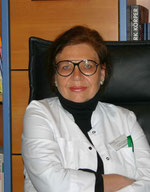
Interview on hyperthermia from Bad Bergzabern with Dr. Rita Koomagi
Fever as therapy support
He who has a fever does not get cancer". Do you also know this sentence from your grandmother? Even before the development of modern hyperthermia devices, fever was considered a "cleansing mechanism" of the body. Today there are many different forms of fever therapy. Hyperthermia can be used locally, regionally or systemically for the whole body. A distinction is made between mild whole-body hyperthermia for body temperatures < 38.5 °C, moderate whole-body hyperthermia for temperatures between 38.5 °C and 40 °C and extreme whole-body hyperthermia for the range > 40 °C. The Association of Gynaecological Oncologists (AGO) has included hyperthermia in conjunction with radiotherapy in its recommendations for the treatment of certain disease situations.
Mamma Mia!: Dr. Koomagi, first of all asked in general terms: What is the difference between whole-body and local hyperthermia and what is used when?
Dr. Rita Koomagi: Whole-body hyperthermia, so-called fever therapy, is a systemic treatment of tumor diseases with the aim of achieving a curative potential.
Locoregional RF deep hyperthermia with capacitively coupled electrodes (13.56 MHz) is an integrative oncological therapy method, also for the treatment of tumors such as breast carcinomas. In the context of local hyperthermia, the aim is to achieve homogeneous tumor or metastasis hyperthermia with a temperature of 41 °C to 43 °C, which is used in combination with chemo- and radiotherapy as well as modern therapeutic measures such as targeted therapies, protein kinase inhibitors, monoclonal antibodies, check point inhibitors or endocrine therapy. Another therapeutic option is local hyperthermia, also without chemo- or radiotherapy, but in combination with mistletoe therapy. Locoregional hyperthermia also includes surface hyperthermia, i.e. the heating of skin and/or tumours and lymph nodes close to the surface in combination with conventional therapeutic measures.
Mamma Mia!: You treat numerous breast cancer patients in your clinic, among others you use hyperthermia. Could you briefly explain to us which patients benefit most from hyperthermia?
**Dr. Rita Koomagi: For breast cancer patients we mainly use the hyperthermia measures mentioned above. Breast cancer patients benefit both from local hyperthermia in combination with the above-mentioned therapeutic measures and during the adjuvant therapy phase, for example in combination with chemotherapy or antibody therapies to potentiate the therapeutic effect. As mentioned above, whole-body hyperthermia is performed as a maintenance therapy after adjuvant therapy. The local hyperthermia can be used after breast-preserving surgery or ablation and after adjuvant radiotherapy as well as in palliative situations, for example after radiation of bone metastases, brain metastases and the thoracic wall in combination with other complementary therapeutic measures.
Mamma Mia!: What does a classic hyperthermia session look like and how often is it repeated? How long are the intervals between the individual hyperthermia cycles?
Dr. Rita Koomagi: Locoregional RF deep hyperthermia with capacitively coupled electrodes (13.56 MHz) is performed every second day in direct temporal connection to radiation and/or chemotherapy. The treatment time per application is approximately one hour. The interval between the hyperthermia cycles is decided by the physician and depends on the further therapy measures or the goal of the treatment. In combination with chemotherapy, the cycles are performed at shorter intervals.
Mamma Mia!: Are there also patients to whom you would not recommend hyperthermia?
Dr. Rita Koomagi: Contraindications are pre-existing comorbidities such as severe diseases of the cardiovascular system, the lungs, severe renal insufficiency, Karnofsky index < 60 % (= index of performance), cachexia (severe underweight), acute infections, severe bone marrow damage, acute influential congestion, acute thromboses, pulmonary embolisms, severe lymphedema, bleeding, in case of local hyperthermia additionally also pacemakers, metal implants, defibrillators. In the case of a breast implant or expander reconstruction, direct hyperthermia is not permitted, but only in the prone position. Patients with claustrophobia should/may not be treated with whole-body hyperthermia/ local hyperthermia. Brain metastases and severe peripheral polyneuropathies are contraindications for whole body hyperthermia, but not for locoregional RF deep hyperthermia with capacitively coupled electrodes (13.56 MHz).
Mamma Mia!: Does the hyperthermia have side effects?
Dr. Rita Koomagi: In general, hyperthermia is a very tolerable therapy without serious side effects. With local hyperthermia, local overheating with redness up to skin burns with pain can occur, which can occur directly during the treatment. Treatment of brain metastases could result in brain edema, prophylactically osmotherapy is used. An effect on the blood count depends on the time of treatment, for example immediately after radiotherapy or chemotherapy. In rare cases, dying tumour cells in the blood could cause tumour markers to rise.
Mamma Mia!: What do patients have to consider after hyperthermia?
Dr. Rita Koomagi: To rest, not to eat too large portions of food. After local overheating with reddening of the skin, the nursing staff must be informed immediately, as well as in case of lymphedema with swelling and circulatory problems. Minor burns must be treated.
Mamma Mia!: What about the reimbursement of this procedure? Do the statutory health insurance companies cover the costs?
Dr. Rita Koomagi: The BioMed Clinic Bad Bergzabern is a supply hospital of the statutory health insurance companies according to § 109 Para. 1 SGB-V in conjunction with § 108 No. 3 SGB-V. The costs for inpatient treatment are thus covered by the statutory health insurance companies, the aid agencies and the private health insurance companies. An application to the private health insurance company for the assumption of costs before the start of treatment is recommended.
The interview was conducted by Eva Schumacher-Wulf, chief editor of the breast cancer magazine MammaMia!
https://mammamia-online.de/
